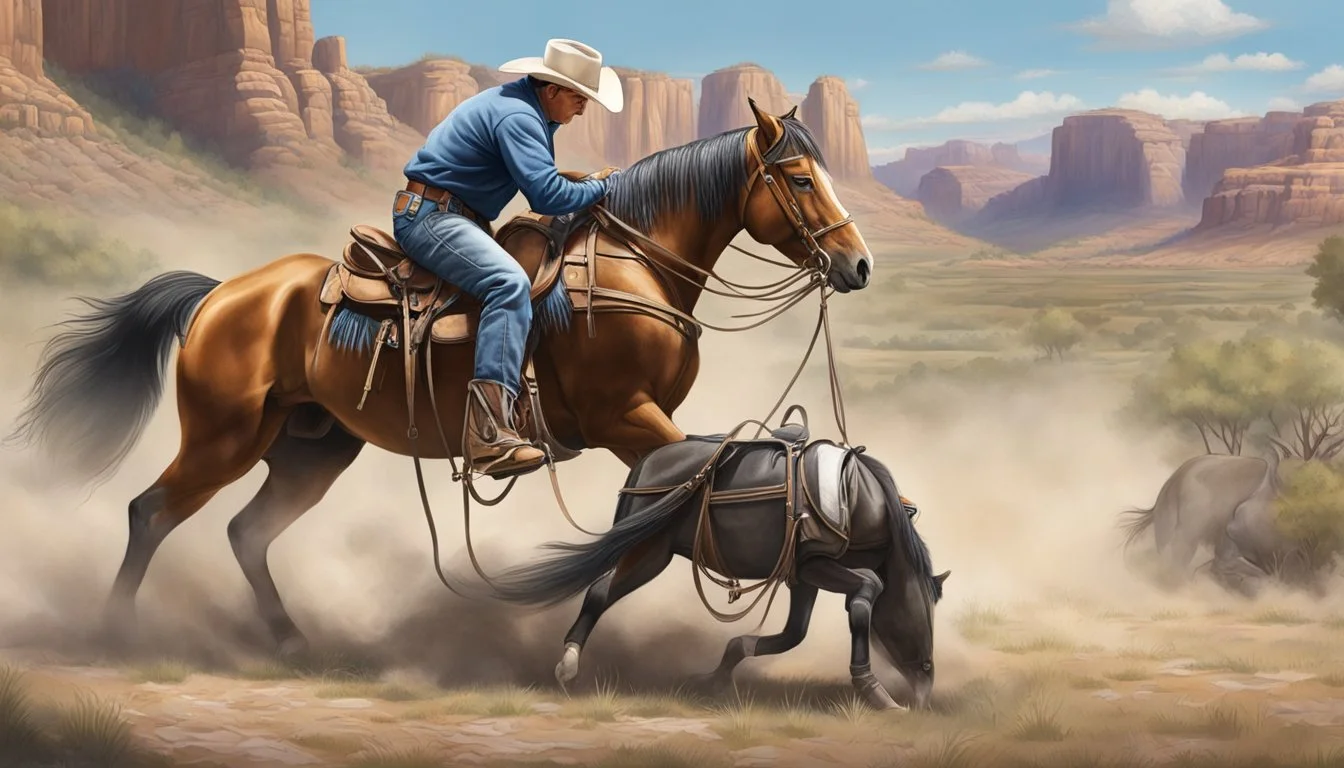The Health and Fitness Regimen of a Working Cowboy
Essential Strategies for Peak Performance
The life of a working cowboy is one that demands not only a deep connection with the land and livestock but also a high level of physical fitness. Rodeo athletes and cowboys engage in a fitness regimen that is uniquely tailored to meet the rigorous demands of their profession. Training programs designed for cowboys often incorporate exercises that build core strength, flexibility, and overall stamina, essential for the tasks they perform daily, whether riding in the rodeo arena or managing cattle on the ranch.
Fitness experts like Doug Champion have specialized in creating training routines for professional rodeo cowboys, emphasizing the importance of fitness not just for athletes but for anyone following a physically demanding lifestyle. The exercises recommended for cowboys are a blend of strength training and cardiovascular workouts that mimic the dynamic movements required in rodeo events. These routines often include crunches, push-ups, leg lifts, and side-abdominal exercises, all aimed at enhancing the rider's ability to endure and perform in challenging conditions.
Developing physical resilience through a systematic workout regimen is crucial for cowboys, as their job often involves unpredictable and strenuous physical activity. The fitness routines designed for these individuals are not only about maintaining physical health; they also contribute to injury prevention, which is vital in a profession where the risk of injury is high. The dedication to staying fit not only supports their work performance but also ensures that cowboys can enjoy a sustainable career in the demanding world of rodeo and ranch work.
Understanding the Cowboy Lifestyle
The cowboy lifestyle involves a range of physical activities that are integral to daily duties on the ranch. These activities contribute to a natural workout regimen, enhancing both strength and endurance.
Physical Demands of the Job
Cowboys perform a variety of tasks that make for a demanding physical workout. A cowboy's day-to-day responsibilities may include:
Horseback Riding: This core activity requires balance and core strength as they maneuver across varying terrains. It engages multiple muscle groups and promotes cardiovascular fitness.
Cattle Herding: This involves short bursts of intense physical activity, navigating the ranch to guide and manage livestock.
Fence Repairing: A task that entails lifting, hammering, and the use of fine motor skills, all contributing to muscle strength and endurance.
Equipment Handling: Handling tools and gear, such as saddles and ropes, further augments their physical regimen by requiring both strength and precision.
Through these regular tasks, cowboys maintain a level of fitness that encompasses cardiovascular health, muscle strengthening, and agility. This physically demanding work has historically shaped the cowboy's ability to handle the rigors of ranch life with resilience and persistence.
Essential Fitness Components for Cowboys
Working cowboys maintain a demanding lifestyle that requires optimal physical fitness to perform tasks effectively. Their health and fitness regimen targets cardiovascular health, strength and conditioning, as well as flexibility and mobility, to ensure they can handle the rigorous demands of cowboy tasks which involve activities like riding, roping, and ranch work.
Cardiovascular Health
Cardiovascular health is critical for cowboys due to the intense nature of their work. Regular aerobic activity not only maintains heart health but also improves blood circulation. Activities such as riding, which can increase the heart rate, double as a form of cardio exercise. Engaging in regular exercise that raises the heartbeat is beneficial, and cowboys often supplement riding with additional cardio exercises like running or swimming to meet their fitness goals.
Examples of Cardio Exercises for Cowboys:
Horse riding at varying speeds
Running, including sprint intervals
Swimming for endurance
Strength and Conditioning
Strength training is a cornerstone of a cowboy's fitness routine, focusing on building the muscle groups used in their daily tasks. Cowboys require upper body strength for activities like handling cattle and equipment, core strength for balance and riding, and lower body strength for tasks that involve lifting and squatting. Regular exercise involving both bodyweight and resistance exercises helps to condition these muscles effectively.
Key Muscle Groups and Exercises:
Upper body: Push-ups, pull-ups
Core: Crunches, planks
Lower body: Squats, deadlifts
Flexibility and Mobility
Flexibility and mobility are vital for cowboys to maintain a good range of motion and prevent injuries. Stretching exercises and balance exercises are integral parts of their regimen. They allow cowboys to achieve the flexibility needed for mounting and dismounting horses, as well as the mobility required for quick directional changes and extended periods of riding.
Techniques for Enhancing Mobility:
Dynamic stretches before starting the day
Yoga to improve flexibility and balance
Nutritional Strategies
For working cowboys, a strategic approach to nutrition is pivotal in managing energy levels and aiding in hydration and recovery. Their demanding lifestyle requires meticulous attention to caloric intake and metabolic needs to sustain performance and reduce recovery time post-physical exertion.
Managing Energy Levels
A working cowboy's diet must be rich in calories and nutrients to match their high energy expenditure. Energy levels are directly influenced by regular consumption of balanced meals that combine complex carbohydrates, lean proteins, and healthy fats.
Complex carbohydrates like whole grains provide a sustained energy release, crucial for long hours of work.
Lean proteins, such as chicken or fish, support muscle repair and growth.
Healthy fats from sources like avocados and nuts contribute to long-lasting energy and can aid in maintaining an optimal metabolic rate.
Incorporating snacks such as low-fat yogurt or a handful of almonds can help maintain stable energy levels throughout the day.
Hydration and Recovery
Effective recovery strategies encompass sufficient hydration and the replenishment of electrolytes lost through sweat. The consumption of fluids is essential, and cowboys should aim for:
Time of Day Suggested Hydration Before Activities At least 16-20 ounces of water Every 15-20 min 6-8 ounces during activities Post Activities Replace each pound lost with 16-24 ounces of water
For optimal recovery, beverages containing sodium and potassium can help restore electrolyte balance. Additionally, consuming a meal with a ratio of 3:1 carbohydrates to protein within 30 minutes post-activity can expedite muscle recovery and prepare the body for the next day's work.
Mental Resilience and Health
Working cowboys face a unique set of mental challenges, akin to other high-pressure professions. Their mental resilience is pivotal for handling stress and maintaining overall mental health. This section delves into their strategies for coping with stress and enhancing focus, essential for their demanding lifestyle.
Coping with Stress
Regular physical activity is integral to a working cowboy’s routine, not only for their job but also for stress management. They engage in moderate to vigorous physical tasks daily, which helps in the release of endorphins, known as the body's natural stress relievers. Combating stress is also linked to outdoor work, which can increase serotonin levels, aiding in mood stabilization and promoting a sense of calm.
Structured relaxation techniques, such as deep breathing exercises or mindful meditation, are beneficial. These practices can improve brain function and reduce symptoms of anxiety and depression. Furthermore, a supportive community among cowboys can act as a social buffer, contributing to stronger self-esteem and mental fortitude.
Enhancing Focus
To enhance focus, a cowboy’s regimen includes maintaining a balanced diet rich in nutrients supportive of brain function and memory enhancement. Foods high in omega-3 fatty acids, antioxidants, and vitamins are prioritized to sustain the high levels of cognitive performance required in their work.
Additionally, adequate rest plays a crucial role. Quality sleep rejuvenates the mind, enabling clearer thought processes and decision-making capabilities. Routine also helps; by maintaining a consistent daily schedule, cowboys can train their brains to focus better, ensuring they are mentally equipped to tackle the multifaceted aspects of their work with precision.
Specific Workouts for Cowboys
In a cowboy's fitness regimen, workouts are tailored to enhance performance in tasks ranging from horseback riding to physically demanding ranch chores and competitive rodeo events. These specialized exercises are developed to improve strength, endurance, and agility necessary for the unique demands of the cowboy lifestyle.
Horseback Riding Drills
Horseback riding requires a strong core to maintain balance and control while maneuvering the horse. Cowboys often engage in core exercises such as planks and Russian twists to build the necessary endurance to stay on a horse, especially for those intense eight seconds during a rodeo. Drills might include:
Mounted exercises for balance and flexibility
Practice rides focusing on sudden stops, turns, and speed control
Ranch Chore Exercises
The day-to-day activities on a ranch provide natural resistance training opportunities. Cowboys utilize functional fitness by simulating these chores within their workout routines. Implementing free weights and resistance bands can replicate the lifting, pulling, and pushing movements associated with ranch work. Some exercises are:
Bicep curls and overhead presses with free weights to mimic lifting feed sacks
Squat and deadlift motions to rehearse lifting and moving equipment
Rodeo Preparation
Preparing for the rodeo circuit demands targeted resistance training to build strength and power. Cowboys often perform exercises that simulate the motions of their rodeo events. This can include:
Bull rider squats using resistance bands to strengthen legs and mimic the motion of a ride
Circuit training that imitates the quick burst of energy needed for roping or wrestling livestock
Incorporating these exercises into a cowboy's routine is vital for both daily ranch work and competitive rodeo success. They are designed with the goal of enhancing performance in specific tasks while mitigating the risk of injury.
Injury Prevention and Management
A working cowboy's health and fitness regimen must emphasize injury prevention and management, focusing on maintaining mobility and reducing recovery time. Targeted pre-workout routines and post-workout care can significantly mitigate the risks associated with the demanding physical activities of a cowboy.
Pre-Workout Routines
For injury prevention, cowboys should engage in dynamic warm-ups to prepare their muscles, tendons, and joints for the strenuous activities ahead. Starting with 5 minutes of light cardio, such as brisk walking or easy cycling, increases blood flow to the tissues, enhancing their elasticity. Resistance training should then follow, emphasizing the lower back, a common site of injury. This can include exercises like:
Bodyweight Squats: 2 sets of 15 to enhance leg and core strength.
Lunges: 2 sets of 12 on each leg to improve balance and stability.
Planks: 1-2 minutes to reinforce lower back and abdominal muscles.
Incorporating mobility drills can further augment a cowboy's range of motion, pivotal to preventing overextension and strain.
Post-Workout Care
After a long day's work, cowboys should focus on recovery to decrease the likelihood of injury and hasten healing time if an injury occurs. Strategies for post-workout care involve:
Stretching: 10 minutes of static stretches, targeting the legs, lower back, and arms can alleviate muscle tension.
Cool-down: A gradual reduction of physical activity helps the body transition into a state of rest and begins the recovery process immediately.
Hydration and Nutrition: Drinking water and consuming a balanced meal rich in protein aids muscle repair.
Health Conditions and Management
Working cowboys lead a physically demanding lifestyle that poses risks of acute injuries and chronic diseases. Proper management and prevention strategies are critical for maintaining their health and fitness.
Preventing Chronic Diseases
Physical Activity: Regular physical activity is crucial for cowboys to mitigate the risk of chronic diseases such as heart disease and diabetes. Cardiovascular exercises, which can range from riding to more structured workouts, help maintain healthy blood pressure and cholesterol levels. It's important they incorporate activities that enhance flexibility and strength to manage weight and improve blood sugar levels.
Diet: A balanced diet plays a significant role in preventing chronic diseases. Cowboys should consume nutrient-dense foods that provide sufficient energy for their demanding jobs while managing blood sugar and reducing inflammation. Diets rich in whole grains, lean proteins, fruits, and vegetables are beneficial in maintaining good health and lowering the risk of diseases.
Dealing with Acute Injuries
Immediate Care: For acute injuries, such as sprains, fractures, or lacerations, immediate application of the R.I.C.E method—rest, ice, compression, and elevation—is recommended. Seeking prompt medical attention is vital to properly assess the injury and begin the appropriate treatment.
Rehabilitation: Post-injury, cowboys may require physical therapy to regain strength and ensure proper healing. A tailored rehabilitation program can help them return to their activities with a reduced risk of re-injury. Collaboration with health professionals ensures the cowboy receives the most appropriate and effective care for his specific needs.
Equipment and Gear
A working cowboy's health and fitness are supported by a carefully selected array of equipment and gear, designed to ensure peak physical performance and safety.
Choosing the Right Fitness Equipment
In the gym, cowboys should look for a balanced mix of dumbbells, weight machines, and resistance machines to target different muscle groups. Dumbbells provide versatility and can be used for a wide range of exercises to improve muscle tone and strength. Weight machines are beneficial for controlled and safe movements, allowing for targeted muscle training. Resistance machines or bands offer dynamic ways to improve flexibility and strength, often mimicking the real-life movements needed on the ranch.
Equipment Type Use Case Benefits Dumbbells Versatile muscle training Improves muscle tone Weight Machines Targeted muscle training Controlled movements Resistance Bands Flexibility and strength training Mimics real-life movements
Bodyweight exercises should not be overlooked, as they require no extra equipment and are easily modifiable to suit different fitness levels. Theses exercises are key for cowboys since they often translate directly to the physical demands of their work.
Maintenance and Safety
Proper maintenance of fitness equipment is crucial to prevent injury and ensure longevity. Each piece of gear must be inspected regularly for wear and tear, with special attention towards equipment that involves high tension or heavy weights. Safe practices include:
Checking equipment before use: Look for any damages or signs of wear.
Regular cleaning: This is especially important for shared gym equipment.
Following manufacturer guidelines: Use the equipment only as intended by the manufacturer to avoid accidents.
Regarding safety, cowboys should always use the appropriate attire, such as gloves and supportive footwear, to protect themselves during workouts. Adequate warm-up routines and cool-down exercises are necessary to keep muscles flexible and prevent strains. They should be aware of their own limits to avoid overexertion, a common risk when handling equipment like heavy dumbbells or engaging in high-intensity resistance training.
Creating a Sustainable Fitness Regimen
In constructing a fitness regimen for a working cowboy, it’s imperative to integrate aspects that develop lean muscle, muscular strength, and endurance through regular exercise, while also ensuring the fitness training is realistically aligned with their demanding lifestyle.
Setting Realistic Goals
When setting goals for a fitness regimen, a cowboy must assess the demands of their daily work and the time they can dedicate to structured exercise. Goals should be specific, measurable, attainable, relevant, and time-bound (SMART).
Specific: A cowboy might aim to increase the amount of lean muscle to improve job performance.
Measurable: Setting benchmarks, such as lifting a certain amount of weight or completing a set amount of tasks with ease.
Attainable: Considering the physical demands of ranch work, one must ensure goals do not lead to overtraining.
Relevant: Each fitness goal should directly enhance their ability to perform work-related tasks, such as increased strength for lifting or enhanced endurance for long days.
Time-bound: Suitable time frames should be established, recognizing that muscle mass and fitness improvements take time.
A balanced fitness regimen for a cowboy should incorporate exercises that simulate work activities, like rope pulling or saddle lifting, which can enhance functional strength and endurance. They should aim to gradually advance in their fitness training without compromising their job duties or risking injury.
Beyond Physical Training
In the life of a working cowboy, maintaining mental agility and sound judgment is equally vital as physical strength. Cognitive skills such as learning new techniques and making quick decisions under pressure are essential. Through activities such as yoga and tai chi, cowboys can enhance their mental clarity and bodily awareness, which are crucial when navigating the unpredictable nature of ranch work.
While not traditional cowboy exercises, yoga and tai chi offer methods to improve balance, flexibility, and core strength. Beyond these, engaging in a variety of aerobic activities supports overall cardiovascular health. The Department of Health and Human Services recommends at least 150 minutes of moderate aerobic activity or 75 minutes of vigorous aerobic activity per week, combined with muscle-strengthening activities on 2 or more days a week.
Cowboys may incorporate:
Cycling or biking to build muscular fitness and bone strength
Swimming for a full-body workout and joint-friendly exercise
Dancing, which is not only a cultural staple but also a form of both aerobic and muscle-strengthening fitness
Lighter activities like walking or jogging for moderate aerobic activity
For those seeking higher intensity, running and high-intensity interval training (HIIT) are excellent for boosting cardiovascular and muscular endurance. Incorporating a combination of these activities supports a well-rounded fitness regimen that extends beyond the physical demands of cowboy work.










